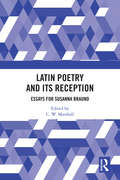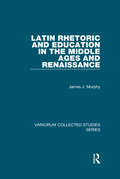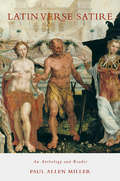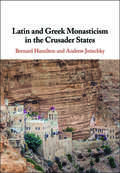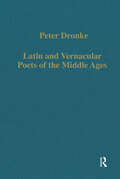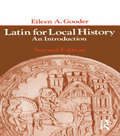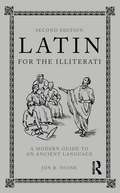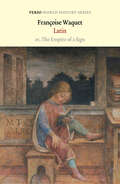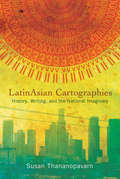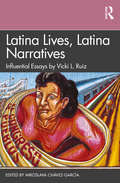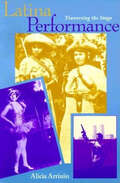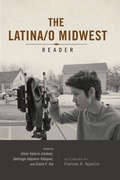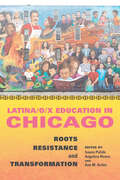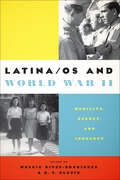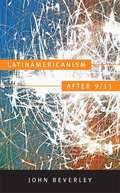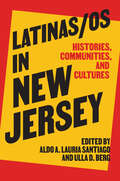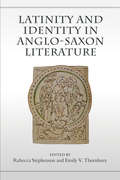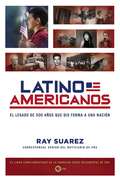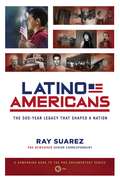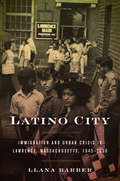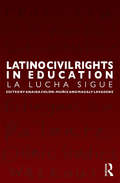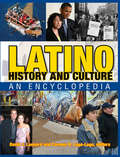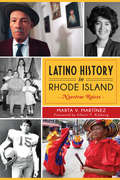- Table View
- List View
Latin Poetry and Its Reception: Essays for Susanna Braund (Routledge Monographs in Classical Studies)
by C. W. MarshallThis volume offers 18 new studies reflecting the latest scholarship on Latin verse, explored both in its original context and in subsequent contexts as it has been translated and re-imagined. All chapters reflect the wide research interests of Professor Susanna Braund, to whom the volume is dedicated. Latin Poetry and Its Reception assembles a blend of senior scholars and new voices in Latin literary studies. It makes important contributions to the understanding of Kingship in Hellenistic and Roman thought, with the first four chapters dedicated to exploring this theme in Republican poetry, Virgil, Seneca, and Statius. Chapters focusing on the modern reception include case studies from the 16th to the 21st century, with discussions on Gavin Douglas, Edward Gibbon, Herman Melville, Igor Stravinsky, and Elena Ferrante, among others. No comparable volume provides a similar range. Latin Poetry and Its Reception will appeal to all scholars of Latin poetry and classical reception, from senior undergraduates to scholars in Classics and other disciplines.
Latin Rhetoric and Education in the Middle Ages and Renaissance (Variorum Collected Studies #827)
by James J. MurphyThe essays in this volume deal with the history of rhetoric and education for the thousand years from the early Middle Ages to the European Renaissance. They represent the author's pioneering efforts over four decades to piece together a kind of mosaic which will provide elements necessary to construct a history of that thousand years of language activity. Some essays deal with individual writers like Giles of Rome, Peter Ramus, Gulielmus Traversanus, or Antonio Nebrija, some focus on the influence of Cicero and Quintilian and other ancient sources. The essays dealing specifically with education open up different inquiries into the ways language use was promoted, and by whom. Others explore the relations between Latin rhetoric and medieval English literature and, finally, several deal with the impact of printing, a subject still not completely understood.
Latin Verse Satire: An Anthology and Reader
by Paul Allen MillerA wide variety of texts by the Latin satirists are presented here in a fully loaded resource to provide an innovative reading of satire's relation to Roman ideology. Brimming with notes, commentaries, essays and texts in translation, this book succeeds in its mission to help the student understand the history of Latin's modern scholarly reception.Focusing on the linguistic difficulties and problems of usage, and examining aspects of meter and style necessary for poetry appreciation, the commentary places each selection in its own historical context then using essays and critical excerpt, the genre's most salient features are elucidated to provide a further understanding of its place in history.Extremely student friendly, this stands well both as a companion to Latin Erotic Elegy and in its own right as an invaluable fund of knowledge for any Latin literature scholar.
Latin and Greek Monasticism in the Crusader States
by Andrew Jotischky Bernard HamiltonMonasticism was the dominant form of religious life both in the medieval West and in the Byzantine world. Latin and Greek Monasticism in the Crusader States explores the parallel histories of monasticism in western and Byzantine traditions in the Near East in the period c.1050-1300. Bernard Hamilton and Andrew Jotischky follow the parallel histories of new Latin foundations alongside the survival and revival of Greek Orthodox monastic life under Crusader rule. Examining the involvement of monasteries in the newly founded Crusader States, the institutional organization of monasteries, the role of monastic life in shaping expressions of piety, and the literary and cultural products of monasteries, this meticulously researched survey will facilitate a new understanding of indigenous religious institutions and culture in the Crusader states.
Latin and Vernacular Poets of the Middle Ages (Variorum Collected Studies)
by Peter DronkeThis volume presents a series of penetrating analyses of particular poems and problems of literary history illustrating the many sides of medieval poetry and the interactions of learned, popular and courtly traditions. The first and longest essay, 'Waltharius-Gaiferos', aims to characterize the diverse treatments of one of the major European heroic themes - in modes that include lay and epic, saga and ballad, and range from pre-Carolingian times to the Renaissance. There follow three interrelated essays on the medieval transformations of Ovid, and a larger group devoted to close reading of medieval lyrics. After discussing some brilliant Latin compositions, of the 9th-12th centuries, both sacred and profane, and the work of two of the most captivating 'goliard' poets, Peter Dronke looks at the earliest formations of love-lyric in two vernaculars, Spanish and English. Finally, he explores the unique symbiosis of Latin and vernacular imagery in two key moments of Dante's Divine Comedy. Ce volume contient une série d’analyses perspicaces de poèmes spécifiques et de certains problèmes de l’histoire littéraire illustrant les multiples facettes de la poésie médiévale et l’interaction des traditions érudites, populaires et courtoises. Le premier essai, "Waltharius-Gaïferos", tente de décrire les divers traitements de l’un des principaux thèmes héroïques européens selon des modes qui incluent: le lai et l’épique, la saga et la ballade et qui s’étendent sur une période allant de l’époque pré-carolingienne à la Renaissance. Suivent trois articles corrélatifs sur les adaptations médiévales des textes d’Ovide, ainsi qu’un groupe d’études voue à la lecture détaillée de la poésie lyrique médiévale. Après avoir considéré l’oeuvre de deux des plus passionnants poètes "goliards" et un certain nombre de remarquables compositions latines, sacrées et profanes, datant du 9e-12e siècles, Peter Dronke se tourne vers les pre
Latin for Local History: An Introduction
by Eileen A. GooderLatin for Local History provides a self-teaching guide for those historians who wish to tackle the language in which the majority of pre-eighteenth century historical records have been written. It is unique in dealing only with Latin found in historical records of the medieval period. Practice material and exercises are provided in the form of documents most commonly encountered by the historian in their research - deeds, charters, court rolls, accounts, bishops' registers and so on.
Latin for the Illiterati: A Modern Guide to an Ancient Language
by Jon R. StoneThis revised and updated edition includes a brand new foreword by Richard LaFleur and more than fifteen hundred new entries and abbreviations. Organized alphabetically within the categories of verba (common words and expressions), dicta (common phrases and familiar sayings), and abbreviations, this practical and helpful reference guide is a comprehensive compendium of more than 7,000 Latin words, expressions, phrases, and sayings taken from the world of art, music, law, philosophy, theology, medicine and the theatre, as well as witty remarks and sage advice from ancient writers such as Virgil, Ovid, Cicero, and more.
Latin: or, the Empire of a Sign (Verso World History Series)
by Françoise WaquetA highly original and accessible history of Latin between the sixteenth and twentieth centuriesFor almost three centuries, Latin dominated the civic and sacred worlds of Europe and, arguably, the entire western world. From the moment in the sixteenth century when it was adopted by the Humanists as the official language for schools and by the Catholic Church as the common liturgical language, it was the way in which millions of children were taught, people prayed to God, and scholars were educated.Francoise Waquet&’s history of Latin between the sixteenth and twentieth centuries is a highly original and accessible exploration of the institutional contexts in which the language was adopted.It goes on to consider what this conferring of power and influence on Latin meant in practice. Among the questions Waquet investigates are: What privileges were, and are still, accorded to those who claim to have studied Latin? Can Latin as a subject for study be anything more than purely linguistic or does it reveal a far more complex heritage? Has Latin&’s deeply embedded cultural legacy already given way to a nostalgic exoticism?Latin: A Symbol&’s Empire is a valuable work of reference, but also an important piece of cultural history: the story of a language that became a symbol with its own, highly significant empire.
LatinAsian Cartographies: History, Writing, and the National Imaginary (Latinidad: Transnational Cultures in the United States)
by Susan ThananopavarnLatinAsian Cartographies examines how Latina/o and Asian American writers provide important counter-narratives to the stories of racial encroachment that have come to characterize twenty-first century dominant discourses on race. Susan Thananopavarn contends that the Asian American and Latina/o presence in the United States, although often considered marginal in discourses of American history and nationhood, is in fact crucial to understanding how national identity has been constructed historically and continues to be constructed in the present day. Thananopavarn creates a new “LatinAsian” view of the United States that emphasizes previously suppressed aspects of national history, including imperialism, domestic racism during World War II, Cold War operations in Latin America and Asia, and the politics of borders in an age of globalization. LatinAsian Cartographies ultimately reimagines national narratives in a way that transforms dominant ideas of what it means to be American.
Latina Lives, Latina Narratives: Influential Essays by Vicki L. Ruiz
by Miroslava Chávez-GarcíaThis book brings together the most influential and widely known writings of Vicki L. Ruiz, a leading voice in the fields of Chicana/o, Latina/o, women’s, and labor history. For nearly forty years, Ruiz has produced scholarship that has provided the foundation for a rich and nuanced understanding of the ways in which Chicanas and Latinas negotiate the structures impinging on their everyday lives. From challenging familial, patriarchal cultural norms, building interethnic social networks in the neighborhood and workplace, and organizing labor unions, to fighting gender and racial discrimination in the courts, at work, in the schools, and on the streets, Ruiz’s studies have examined the countless struggles, roadblocks, and victories Chicanas and Latinas have faced in the twentieth century and beyond. The articles in this book are organized chronologically to reflect the evolution of Ruiz’s intellectual contributions as well as her commitment to integrating feminist history, theory, and methodology, and show how she has generously offered insights, reflections, and humor in helping us define and shape who we are as mujeres, Chicanas, Latinas, scholars, teachers, and mentors. With its narrative flow and engaging prose, Ruiz’s scholarship connects with academic and public audiences and this collection fulfills a much-needed demand in the teaching of women’s, Chicana/o, Latina/o, and labor history.
Latina Performance: Traversing the Stage
by Alicia ArrizónA study exploring the role of Latina women in theater performance, literature, and criticism.Arrizón’s examination of Latina performance spans the twentieth century, beginning with oral traditions of corrido and revistas. She examines the soldadera and later theatrical personalities such as La Chata Noloesca and contemporary performance artist Carmelita Tropicana.Latina Performance considers the emergence of Latina aesthetics developed in the United States, but simultaneously linked with Latin America. As dramatists, performance artists, protagonists, and/or cultural critics, the women Arrizón examines in this book draw attention to their own divided position. They are neither Latin American nor Anglo, neither third- or first-world; they are feminists, but not quite “American style.” This in-between-ness is precisely what has created Latina performance and performance studies, and has made “Latina” an allegory for dual national and artistic identities.“Alicia Arrizón’s Latina Performance is a truly innovative and important contribution to Latino Studies as well as to theater and performance studies.” —Diana Taylor, New York University“Arrizón’s . . . important book revolves around the complex issues of identity formation and power relations for US women performers of Latin American descent. . . . Valuable for anyone interested in theater history and criticism, cultural studies, gender studies, and ethnic studies with attention to Mexican American, Chicana/o, and Latina/o studies. Upper—division undergraduates through professionals.” —E. C. Ramirez, Choice
Latina/o Midwest Reader
by Omar Valerio-Jimenez Santiago Vaquera-VasquezFrom 2000 to 2010, the Latino population increased by more than 73 percent across eight midwestern states. These interdisciplinary essays explore issues of history, education, literature, art, and politics defining today’s Latina/o Midwest. Some contributors delve into the Latina/o revitalization of rural areas, where communities have launched bold experiments in dual-language immersion education while seeing integrated neighborhoods, churches, and sports teams become the norm. Others reveal metro areas as laboratories for emerging Latino subjectivities, places where for some, the term Latina/o itself corresponds to a new type of lived identity as different Latina/o groups interact in shared neighborhoods, schools, and workplaces. Eye-opening and provocative, The Latina/o Midwest Reader rewrites the conventional wisdom on today's Latina/o community and how it faces challenges—and thrives—in the heartland. Contributors: Aidé Acosta, Frances R. Aparicio, Jay Arduser, Jane Blocker, Carolyn Colvin, María Eugenia Cotera, Theresa Delgadillo, Lilia Fernández, Claire F. Fox, Felipe Hinojosa, Michael D. Innis-Jiménez, José E. Limón, Marta María Maldonado, Louis G. Mendoza, Amelia María de la Luz Montes, Kim Potowski, Ramón H. Rivera-Servera, Rebecca M. Schreiber, Omar Valerio-Jiménez, Santiago Vaquera-Vásquez, Darrel Wanzer-Serrano, Janet Weaver, and Elizabeth Willmore
Latina/o/x Education in Chicago: Roots, Resistance, and Transformation (Latinos in Chicago and Midwest)
by Nilda Flores-González Lilia Fernández Jaime Alanís Ann M Avilés Gabriel Alejandro Cortez Erica R Dávila Cristina Pacione-Zayas Isaura Pulido Angelica Rivera Arlene Torres Mirelsie Velázquez Leticia Villarreal SosaIn this collection, local experts use personal narratives and empirical data to explore the history of Mexican American and Puerto Rican education in the Chicago Public Schools (CPS) system. The essays focus on three themes: the historical context of segregated and inferior schooling for Latina/o/x students; the changing purposes and meanings of education for Latina/o/x students from the 1950s through today; and Latina/o/x resistance to educational reforms grounded in neoliberalism. Contributors look at stories of student strength and resistance, the oppressive systems forced on Mexican American women, the criminalization of Puerto Ricans fighting for liberatory education, and other topics of educational significance. As they show, many harmful past practices remain the norm--or have become worse. Yet Latina/o/x communities and students persistently engage in transformative practices shaping new approaches to education that promise to reverberate not only in the city but nationwide. Insightful and enlightening, Latina/o/x Education in Chicago brings to light the ongoing struggle for educational equity in the Chicago Public Schools.
Latina/os and World War II: Mobility, Agency, and Ideology
by Maggie Rivas-RodríguezThis eye-opening anthology documents the effects of WWII on Latina/o personal and political beliefs across a broad spectrum of ethnicities and races.The first book-length study of Latina/o experiences in World War II over a wide spectrum of identities and ancestries—from Cuban American, Spanish American, and Mexican American segments to the under-studied Afro-Latino experience—Latina/os and World War II probes the controversial aspects of Latina/o soldiering and citizenship in the war, the repercussions of which defined the West during the twentieth century. The editors also offer a revised, more accurate tabulation of the number of Latina/os who served in the war.Spanning imaginative productions, such as vaudeville and the masculinity of the soldado razo theatrical performances; military segregation and the postwar lives of veterans; Tejanas on the homefront; journalism and youth activism; and other underreported aspects of the wartime experience, the essays collected in this volume showcase rarely seen recollections. Whether living in Florida in a transformed community or deployed far from home (including Mexican Americans who were forced to endure the Bataan Death March), the men and women depicted in this collection yield a multidisciplinary, metacritical inquiry. The result is a study that challenges celebratory accounts and deepens the level of scholarly inquiry into the realm of ideological mobility for a unique cultural crossroads. Taking this complex history beyond the realm of war narratives, Latina/os and World War II situates these chapters within the broader themes of identity and social change that continue to reverberate in postcolonial lives.
Latina/os and World War II: Mobility, Agency, and Ideology
by Maggie Rivas-RodríguezThis eye-opening anthology documents the effects of WWII on Latina/o personal and political beliefs across a broad spectrum of ethnicities and races.The first book-length study of Latina/o experiences in World War II over a wide spectrum of identities and ancestries—from Cuban American, Spanish American, and Mexican American segments to the under-studied Afro-Latino experience—Latina/os and World War II probes the controversial aspects of Latina/o soldiering and citizenship in the war, the repercussions of which defined the West during the twentieth century. The editors also offer a revised, more accurate tabulation of the number of Latina/os who served in the war.Spanning imaginative productions, such as vaudeville and the masculinity of the soldado razo theatrical performances; military segregation and the postwar lives of veterans; Tejanas on the homefront; journalism and youth activism; and other underreported aspects of the wartime experience, the essays collected in this volume showcase rarely seen recollections. Whether living in Florida in a transformed community or deployed far from home (including Mexican Americans who were forced to endure the Bataan Death March), the men and women depicted in this collection yield a multidisciplinary, metacritical inquiry. The result is a study that challenges celebratory accounts and deepens the level of scholarly inquiry into the realm of ideological mobility for a unique cultural crossroads. Taking this complex history beyond the realm of war narratives, Latina/os and World War II situates these chapters within the broader themes of identity and social change that continue to reverberate in postcolonial lives.
Latinamericanism after 9/11
by John BeverleyIn Latinamericanism after 9/11, John Beverley explores Latinamericanist cultural theory in relation to new modes of political mobilization in Latin America. He contends that after 9/11, the hegemony of the United States and the neoliberal assumptions of the so-called Washington Consensus began to fade in Latin America. At the same time, the emergence in Latin America of new leftist governments--the marea rosada or "pink tide"--gathered momentum. Whatever its outcome, the marea rosada has shifted the grounds of Latinamericanist thinking in a significant way. Beverley proposes new paradigms better suited to Latin America's reconfigured political landscape. In the process, he takes up matters such as Latin American postcolonial and cultural studies, the relation of deconstruction and Latinamericanism, the persistence of the national question and cultural nationalism in Latin America, the neoconservative turn in recent Latin American literary and cultural criticism, and the relation between subalternity and the state. Beverley's perspective flows out of his involvement with the project of Latin American subaltern studies, but it also defines a position that is in some ways postsubalternist. He takes particular issue with recent calls for a "posthegemonic" politics.
Latinas/os in New Jersey: Histories, Communities, and Cultures (CERES: Rutgers Studies in History)
by Lilia Fernandez Johana Londoño Ulla D. Berg Raymond Sanchez Mayers Ana Y. Ramos-Zayas Lyna L. Wiggins Kathleen López Yamil Avivi Benjamin Lapidus Aldo A. Lauria Santiago Olga Jiménez de Wagenheim Elsa Candelario Laura Curran Giovani Burgos Alex F. Trillo Anil Venkatesh Jennifer Ayala Giancarlo Muschi Ismael García Colón William Suárez Gómez Elena Sabogal Melanie Z. Plasencia Daniela ValdesSince the 1890s, New Jersey has attracted hundreds of thousands of Caribbean and Latin American migrants. The state’s rich economic history, high-income suburbs, and strong public sector have all contributed to attracting, retaining, and setting the stage for Latin American and Caribbean immigrants and secondary-step migrants from New York City. Since the 1980s, however, Latinos have developed a more complex presence in the state’s political landscape and institutions. The emergence of Latino-majority towns and cities and coalition politics facilitated the election of Latino mayors, council persons, and many social and community leaders, as well as the election of statewide officers. This collection brings together innovative and empirically grounded scholarship from different disciplines and interdisciplinary fields of study and addresses topics including the demographic history of Latinos in the state, Latino migration from gateway cities to suburban towns, Latino urban enclaves, Latino economic and social mobility, Latino students and education, the New Jersey Dream Act and in-state tuition act organizing, Latinos and criminal justice reform, Latino electoral politics and leadership, and undocumented communities. Contributors: Yamil Avivi; Jennifer Ayala; Ulla D. Berg; Giovani Burgos; Elsa Candelario; Laura Curran; Lilia Fernández; Ismael García Colón; Olga Jiménez de Wagenheim; Benjamin Lapidus; Aldo A. Lauria Santiago; Johana Londoño; Kathleen Lopez; Giancarlo Muschi; Melanie Z. Plasencia; Ana Y. Ramos-Zayas; Elena Sabogal; Raymond Sanchez Mayers; William Suárez Gómez; Alex F. Trillo; Daniela Valdez; Anil Venkatesh; Lyna L. Wiggins
Latinity and Identity in Anglo-Saxon Literature
by Rebecca Stephenson Emily ThornburyFor the Anglo-Saxons, Latin was a language of choice that revealed a multitude of beliefs and desires about themselves as subjects, believers, scholars, and artists. In this groundbreaking collection, ten leading scholars explore the intersections between identity and Latin language and literature in Anglo-Saxon England. Ranging from the works of the Venerable Bede and St Boniface in the eighth century to Osbern's account of eleventh-century Canterbury, Latinity and Identity in Anglo-Saxon Literature offers new insights into the Anglo-Saxons' ideas about literary form, monasticism, language, and national identity.Latin prose, poetry, and musical styles are reconsidered, as is the relationship between Latin and Old English. Monastic identity, intertwined as it was with the learning of Latin and reformation of the self, is also an important theme. By offering fresh perspectives on texts both famous and neglected, Latinity and Identity will transform readers' views of Anglo-Latin literature.
Latino Americanos
by Ray SuarezEL LIBRO COMPLEMENTARIO DE LA CONOCIDA SERIE DOCUMENTAL DE PBS Latino americanos relata la rica y variada historia de los Latinos que han contribuido a darle forma a nuestra nación, y quienes se han convertido --con más de 50 millones de personas-- en la minoría más numerosa de los Estados Unidos. Este complemento de la conocida miniserie de PBS relata, de manera vívida y franca, cómo la historia de los lationamericanos es la historia de nuestro país. El aclamado periodista y autor Ray Suarez explora las vidas de hombres y mujeres latinoamericanos en un periodo de quinientos años, e incluye una gama épica de experiencias que abarca desde los primeros asentamientos europeos al Destino Manifiesto; del Salvaje Oeste a la Guerra Fría; de la Gran Depresión a la globalización; de la Guerra Hispano-Estadounidense al movimiento de los derechos civiles. Latino americanos comparte las luchas personales y los éxitos de inmigrantes, poetas, soldados y muchos otros: individuos que han causado un impacto en la historia y aquellos cuyas extraordinarias vidas iluminan la época en que vivieron, así como el legado de estos sensacionales estadounidenses.
Latino Americans
by Ray SuarezTHE COMPANION BOOK TO THE PBS DOCUMENTARY SERIES Latino Americans chronicles the rich and varied history of Latinos, who have helped shaped our nation and have become, with more than fifty million people, the largest minority in the United States. This companion to the landmark PBS miniseries vividly and candidly tells how the story of Latino Americans is the story of our country. Author and acclaimed journalist Ray Suarez explores the lives of Latino American men and women over a five-hundred-year span, encompassing an epic range of experiences from the early European settlements to Manifest Destiny; the Wild West to the Cold War; the Great Depression to globalization; and the Spanish-American War to the civil rights movement. Latino Americans shares the personal struggles and successes of immigrants, poets, soldiers, and many others-individuals who have made an impact on history, as well as those whose extraordinary lives shed light on the times in which they lived, and the legacy of this incredible American people. .
Latino City: Immigration and Urban Crisis in Lawrence, Massachusetts, 1945–2000 (Justice, Power, and Politics)
by Llana BarberLatino City explores the transformation of Lawrence, Massachusetts, into New England's first Latino-majority city. Like many industrial cities, Lawrence entered a downward economic spiral in the decades after World War II due to deindustrialization and suburbanization. The arrival of tens of thousands of Puerto Ricans and Dominicans in the late twentieth century brought new life to the struggling city, but settling in Lawrence was fraught with challenges. Facing hostility from their neighbors, exclusion from local governance, inadequate city services, and limited job prospects, Latinos fought and organized for the right to make a home in the city. In this book, Llana Barber interweaves the histories of urban crisis in U.S. cities and imperial migration from Latin America. Pushed to migrate by political and economic circumstances shaped by the long history of U.S. intervention in Latin America, poor and working-class Latinos then had to reckon with the segregation, joblessness, disinvestment, and profound stigma that plagued U.S. cities during the crisis era, particularly in the Rust Belt. For many Puerto Ricans and Dominicans, there was no "American Dream" awaiting them in Lawrence; instead, Latinos struggled to build lives for themselves in the ruins of industrial America.
Latino Civil Rights in Education: La Lucha Sigue (Series in Critical Narrative)
by Anaida Colon-Muniz Magaly LavadenzLatino Civil Rights in Education: La Lucha Sigue documents the experiences of historical and contemporary advocates in the movement for civil rights in education of Latinos in the United States. These critical narratives and counternarratives discuss identity, inequality, desegregation, policy, public school, bilingual education, higher education, family engagement, and more, comprising an ongoing effort to improve the conditions of schooling for Latino children. Featuring the perspectives and research of Latino educators, sociologists, historians, attorneys, and academics whose lives were guided by this movement, the book holds broad applications in the study and continuation of social justice and activism today.
Latino History and Culture: An Encyclopedia
by David J. Leonard Carmen R. Lugo-LugoLatinos are the fastest growing population in America today. This two-volume encyclopedia traces the history of Latinos in the United States from colonial times to the present, focusing on their impact on the nation in its historical development and current culture. "Latino History and Culture" covers the myriad ethnic groups that make up the Latino population. It explores issues such as labor, legal and illegal immigration, traditional and immigrant culture, health, education, political activism, art, literature, and family, as well as historical events and developments. A-Z entries cover eras, individuals, organizations and institutions, critical events in U.S. history and the impact of the Latino population, communities and ethnic groups, and key cities and regions. Each entry includes cross references and bibliographic citations, and a comprehensive index and illustrations augment the text.
Latino History in Rhode Island: Nuestras Raices (American Heritage)
by Marta V. Martínez Albert T. KlybergIn 1956, the Rosarios came to Providence and opened the first Hispanic food market in Rhode Island. This Dominican family's move signaled a new era of Latin American migration for the Ocean State. In the mid-1960s, Guatemalans came to Rhode Island as refugees from the dirty war at home, and Puerto Ricans arrived in the 1920s looking for agricultural work. From the Colombian factory workers who settled in Central Falls in the mid-1960s to the Cubans who fled Castro's revolution in the 1950s and 1960s, Latin Americans were flocking to the coastal towns and quaint neighborhoods of Rhode Island looking for brighter futures and a place to call home. Join author Marta V. Martinez as she turns a collection of oral histories into a fascinating story of the birth of Rhode Island's vibrant Latino community.
